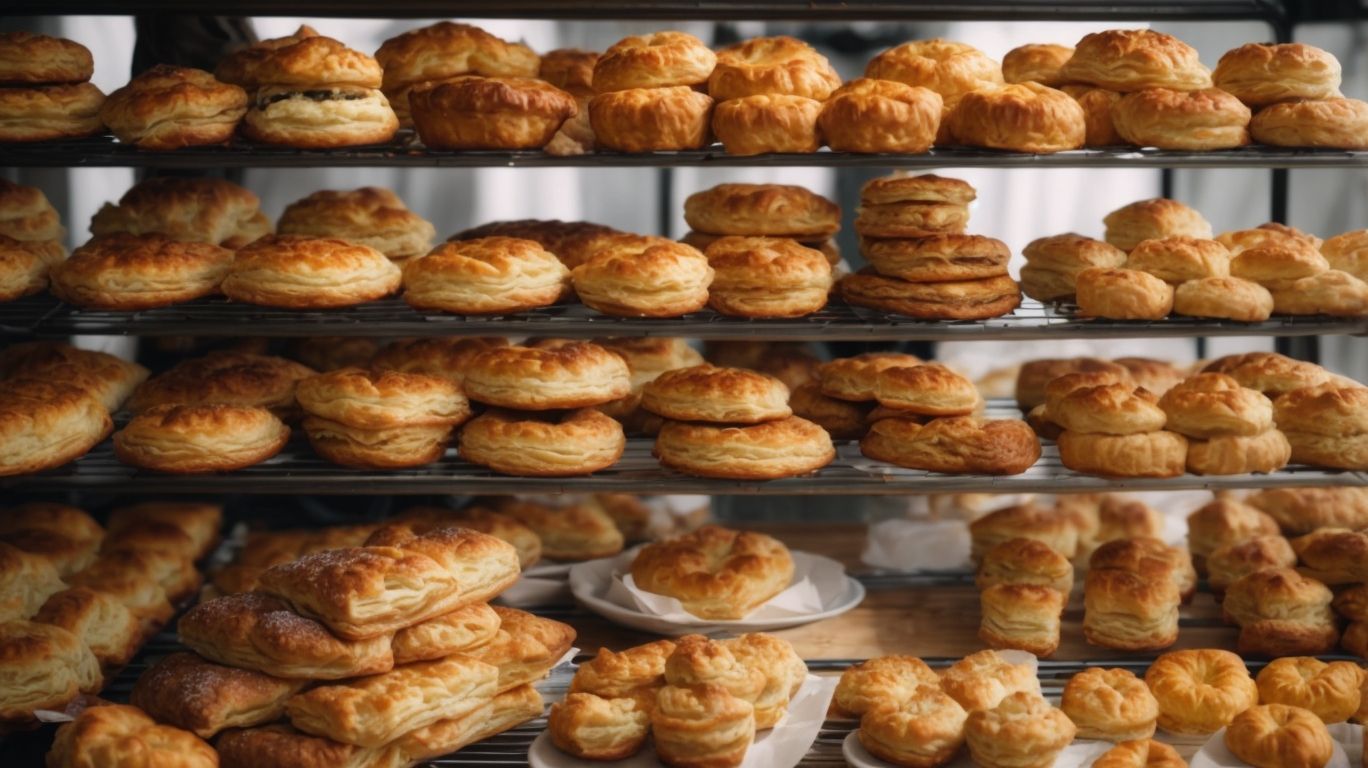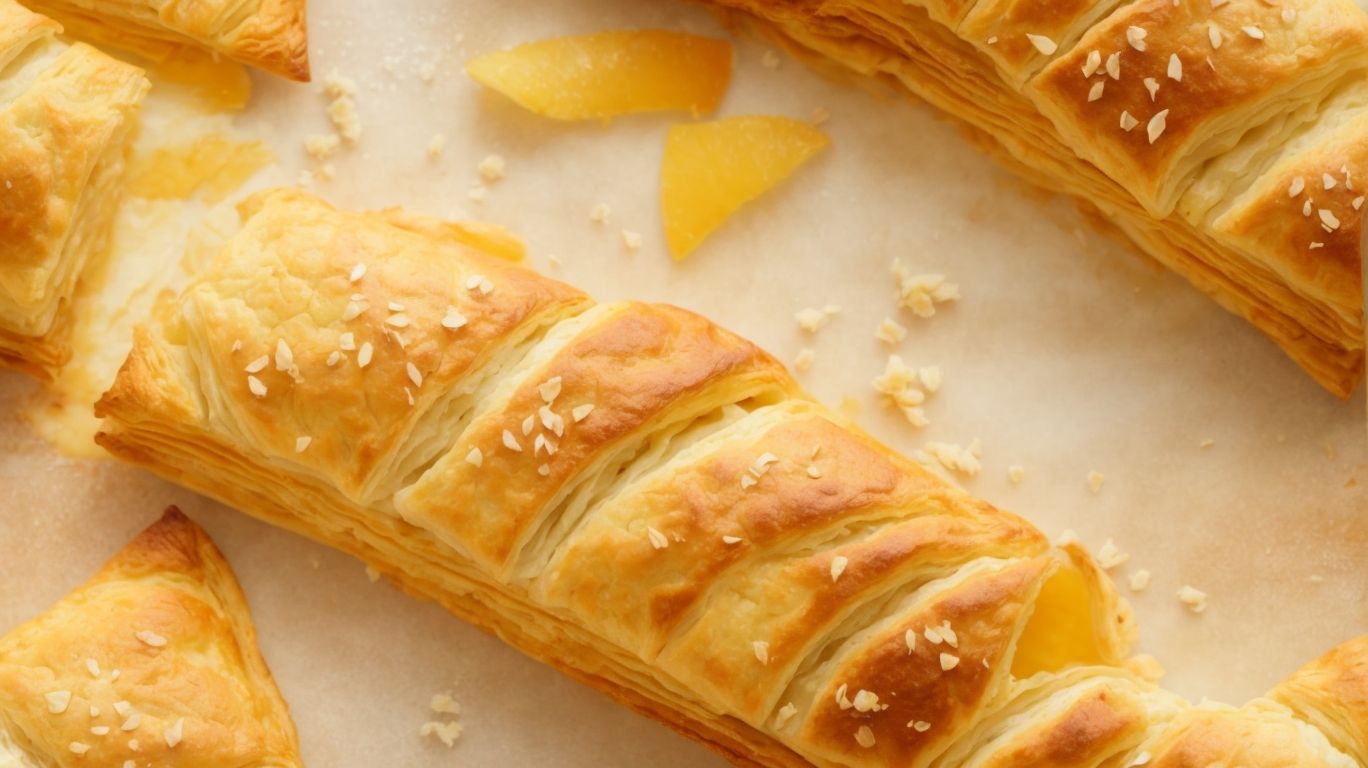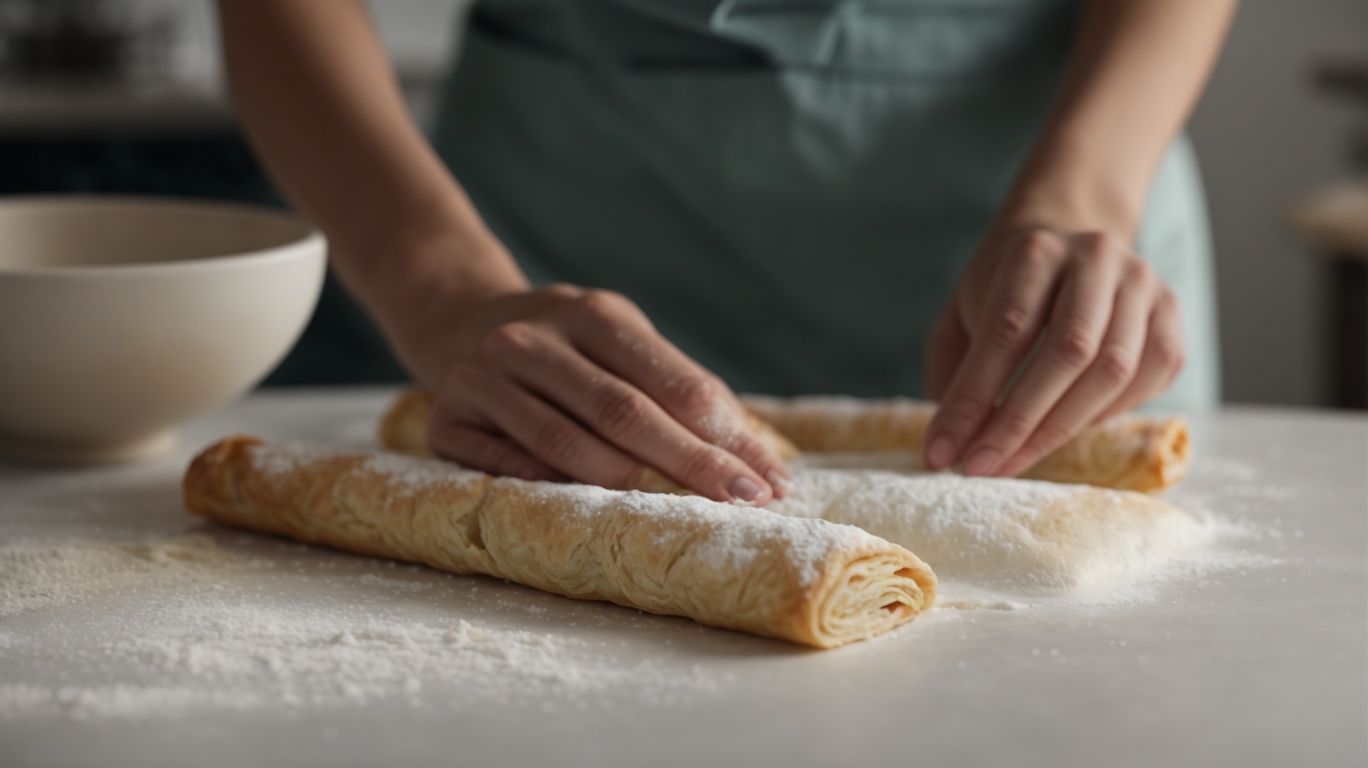How to Bake With Puff Pastry?
Have you ever wondered what makes puff pastry so light, flaky, and delicious?
Explore the world of puff pastry, from its ingredients to its unique characteristics that set it apart from other pastry doughs. Learn how to properly prepare and bake with puff pastry, including tips and tricks for handling this versatile dough.
Whether you’re looking to make appetizers, desserts, or main dishes, puff pastry is a versatile ingredient that can elevate any dish to gourmet status. Dive into the wonderful world of baking with puff pastry!
Key Takeaways:
What is Puff Pastry?
Puff pastry is a versatile and flaky pastry known for its multiple delicate layers achieved through a specific folding and rolling technique.
This technique involves alternating layers of thin dough and butter, which are repeatedly folded and rolled out. Each fold traps air between the layers, creating the characteristic light and airy texture of puff pastry. The process of creating these layers requires precision and patience, as the dough must be chilled between each fold to ensure the butter remains cold and distinct from the dough.
What are the Ingredients of Puff Pastry?
The key ingredients for puff pastry include butter, cold water, and flour, with variations like rough puff pastry incorporating different folding techniques.
Butter plays a crucial role in creating the layers and flakiness of puff pastry. It helps form thin layers when folded between the dough, creating that characteristic light and airy texture. Cold water is essential for keeping the butter cold during the preparation process, ensuring it doesn’t melt too quickly and maintains the structure of the pastry. Flour acts as the base, providing structure and stability to hold the layers together. Rough puff pastry, on the other hand, simplifies the process by using quicker folding techniques while still achieving a similar result.
What is the Difference Between Puff Pastry and Other Pastry Doughs?
Puff pastry stands out from other pastry doughs due to its unique flaky layers created by repetitive rolling and folding, unlike pie crust or yeast-based doughs.
When making puff pastry, the key lies in the precise technique of laminating the dough, which involves encasing a butter block within the dough, then rolling and folding it multiple times to create those delicate layers.
Contrary to pie crust, which is more tender and crumbly, puff pastry boasts a distinct light and airy texture that results from this careful process.
Using a pastry cutter helps maintain the desired consistency and size of butter within the dough, ensuring each layer is evenly distributed.
How to Prepare Puff Pastry for Baking?

Credits: Poormet.Com – Mason Nelson
Preparing puff pastry for baking involves precise folding, chilling, and refrigeration steps that are repeated multiple times to create the desired flaky layers.
During the initial folding process, the butter is enveloped in the dough, creating distinct layers that will puff up during baking. After each fold, the dough must be chilled to ensure the butter remains cold and solid, which is crucial for achieving those flaky layers. The repeated folding and chilling help to create a laminated effect, with alternating layers of dough and butter. This process requires patience and attention to detail, but the end result is a buttery, flaky pastry that is well worth the effort.
What is the Proper Way to Thaw Puff Pastry?
Thawing puff pastry correctly involves a delicate balance of maintaining its chilled state to preserve the butter layers and prevent excess moisture absorption.
When thawing puff pastry, it’s crucial to plan ahead and allow it to defrost gradually in the refrigerator – this slow process ensures that the butter layers remain intact, promoting flakiness in the final product. Avoid the temptation to rush this step by using quick-thaw methods, as they can compromise the texture and quality of the pastry. Additionally, limiting its exposure to water is essential to prevent sogginess – always keep it wrapped in plastic or parchment paper to shield it from any moisture in the surrounding environment.
How to Roll Out Puff Pastry?
Rolling out puff pastry requires a floured surface, a gentle touch with a rolling pin, and precise folding techniques to maintain the integrity of the pastry crust.
Begin by sprinkling a small amount of flour onto your work surface to prevent the pastry from sticking. Place the chilled pastry on the floured surface; use the rolling pin to press down gently, starting from the center and rolling outwards. Rotate the dough periodically to ensure even thickness. As you roll, keep the edges straight for a uniform shape. When the pastry reaches the desired size, fold it gently into thirds, creating precise layers. This technique will help achieve the signature flaky texture of puff pastry.
What Are Some Tips for Handling Puff Pastry?
When handling puff pastry, remember to treat it delicately like a business letter, ensuring precise cuts for creations like Mille-feuille and using a baking sheet for optimal results.
One essential technique for working with puff pastry is to keep it chilled until ready to use, as this helps maintain its flaky texture and prevents it from becoming too sticky.
Gently rolling out the pastry with a lightly floured surface can ensure even thickness and a uniform bake. Be mindful of the temperature in your environment, as puff pastry is sensitive and can melt quickly in warm conditions.
What Can You Make with Puff Pastry?

Credits: Poormet.Com – Aaron Lee
Puff pastry opens up a world of culinary possibilities, from delectable appetizers to mouthwatering desserts and savory main dishes.
Whether you’re looking to create elegant vol-au-vents for a sophisticated gathering or indulgent apple turnovers for a cozy night in, puff pastry offers a blank canvas for your culinary imagination. Its light, flaky layers add a delightful crunch to sweet and savory dishes alike, making it a versatile staple in any kitchen. Impress your guests with golden brown palmiers sprinkled with sugar, or elevate your mealtime routine with a creamy chicken pot pie encased in buttery pastry. The options are endless when it comes to transforming ordinary ingredients into extraordinary creations with the magic of puff pastry.
Puff Pastry Appetizers
Puff pastry appetizers offer a delightful array of flavors and textures, made possible by precise cuts using a pastry cutter and expertly combining butter and water for richness.
The key to achieving perfectly flaky and light puff pastry lies in the meticulous preparation and combination of ingredients. When using a pastry cutter, one can ensure uniformity in the pastry’s layers, resulting in a consistent and professional finish. Butter serves to create those tender, buttery layers that melt in your mouth, while water adds moisture and helps the dough rise beautifully during baking. This harmonious blend of butter and water elevates the overall taste and texture, making each bite a heavenly experience.
Puff Pastry Desserts
Puff pastry desserts delight the senses with layers of flaky goodness, achieved through the careful integration of cold butter, rolling techniques, and precise folding methods.
When crafting puff pastry, the key is to ensure the butter remains cold throughout the process. This is crucial for creating those signature flaky layers that make each bite heavenly. By using cold butter, you allow it to create steam as it bakes, causing the pastry to puff up and become beautifully crisp.
- The rolling technique is another important aspect to master. This involves rolling out the dough with consistent pressure and in a uniform manner to maintain an even thickness.
- The folding method, known as the ‘turn,’ involves layering the dough and butter in a precise manner to create those intricate, delicate layers that define puff pastry desserts.
Puff Pastry Main Dishes
Puff pastry main dishes offer a delightful twist on savory classics, requiring expert rolling skills, precise chilling at intervals, and multiple folding times for a decadent outcome.
Mastering the art of rolling out the delicate layers of puff pastry is crucial for achieving that desirable flaky texture. It’s the backbone of creating these delectable dishes, ensuring each bite is light yet satisfying. Strategically chilling the dough between each fold is a game-changer, allowing the butter to create those signature airy pockets when baked. The repetitive folding process might sound tedious, but it’s the secret to those impressive layers that make puff pastry creations so irresistible.
How to Bake with Puff Pastry?
Baking with puff pastry involves mastering the art of golden crusts, buttery layers, and the perfect balance of moisture within the dough for exceptional results.
When preparing puff pastry, it is crucial to keep the butter cold to create those sought-after flaky layers. The key to achieving that beautiful golden crust lies in the proper handling of the dough and ensuring it is well-chilled before baking. This helps the pastry layers puff up evenly, creating a light and airy texture. To maintain the optimal dough moisture, it’s advisable to handle the dough gently and refrigerate it between each fold to prevent the butter from melting too quickly.
Preparing the Pastry
Preparing the pastry sets the stage for flaky perfection, where the harmonious blend of water and butter creates the signature layers that make puff pastry a culinary delight.
This combination is crucial because the steam created by the water during baking puffs up the layers that were created by the butter, resulting in that sought-after light and airy texture.
Ensuring the temperature of these key ingredients is just right is fundamental, with cold butter being essential to keep it from blending too thoroughly into the flour, allowing those distinguishable flaky layers to form.
Baking Techniques
Mastering the art of baking puff pastry involves precise folding techniques, strategic rolling practices, and strategic refrigeration intervals to achieve the desired flaky texture.
One crucial aspect of successful puff pastry creation is the exactitude in folding the dough layers with precision, ensuring even distribution of butter for that delightful flakiness. This meticulous process guarantees a multi-layered structure that puffs up beautifully in the oven, resulting in that classic airy texture. When rolling out the dough, it is essential to maintain consistent thickness across the entire surface to promote uniform rise and flakiness.
Strategic refrigeration intervals play a key role in the development of puff pastry. Chill the dough at specific intervals to allow the gluten to relax, which prevents toughness and helps in achieving those sought-after light and crispy layers. By understanding and implementing these advanced baking techniques, any aspiring baker can elevate their pastry creations to a professional level.
Common Mistakes to Avoid
Avoid common pitfalls such as treating puff pastry like pie crust, using yeast inappropriately, or compromising on butter layers to ensure a successful baking experience.
When working with puff pastry, it’s crucial to remember that it is not the same as pie crust. Unlike pie crust, puff pastry relies on precise layering and butter distribution to achieve its signature flakiness and height. Incorrectly using yeast in puff pastry can lead to undesirable results, as the dough structure differs significantly. Therefore, always follow recipes that specifically call for yeast and adhere to proofing times diligently.
The preservation of butter layers is a key factor in creating those airy, delicate pockets in puff pastry. Rushing this process or skimping on butter can result in a dense, flat pastry rather than the light and crispy texture desired. Take your time with each fold and chilling step to allow the butter to remain distinct within the layers.
Conclusion: Tips and Tricks for Baking with Puff Pastry

Credits: Poormet.Com – Daniel Young
Mastering the art of baking with puff pastry requires attention to detail in following the recipe, using cold butter, and carefully balancing water content for exceptional results.
It is imperative to ensure that the butter used in puff pastry is cold and firm when incorporating it into the dough. The chilly butter helps create those desirable flaky layers. You can achieve this by chilling the butter and even freezing it for a short while before working it into the pastry.
Following the recipe meticulously is crucial as the ratios of ingredients and the specific steps are designed to yield the best texture and taste. When adding the water, go slow and aim for just enough moisture to hold the dough together without making it too wet. This delicate balance contributes significantly to the pastry’s final texture.
Frequently Asked Questions
1. What is puff pastry and how is it different from other types of pastry?
Puff pastry is a light, flaky pastry that is made by repeatedly layering dough and butter together, then baking it. It is different from other types of pastry because it has many layers of dough and butter, which gives it a light and flaky texture.
2. How do I properly thaw puff pastry before baking?
It is best to thaw puff pastry in the fridge overnight, but if you’re short on time, you can thaw it at room temperature for about 30 minutes. Just make sure to keep it covered to prevent it from drying out.
3. Can I use puff pastry as a substitute for pie crust?
Yes, you can use puff pastry as a substitute for pie crust. However, keep in mind that the texture and flavor will be different. Puff pastry is lighter and flakier, while pie crust is more dense and buttery.
4. How do I prevent puff pastry from getting soggy?
To prevent puff pastry from getting soggy, make sure to dock (prick with a fork) the pastry before baking. This allows steam to escape and prevents the pastry from becoming too moist.
5. Can I freeze puff pastry after baking?
Yes, you can freeze puff pastry after baking. Just let it cool completely, then wrap it tightly in plastic wrap and place it in an airtight container. It can be frozen for up to 3 months.
6. Can I use puff pastry to make savory dishes?
Absolutely! Puff pastry is versatile and can be used for both sweet and savory dishes. Some popular savory dishes include homemade pot pies, chicken Wellington, and ham and cheese pinwheels. Get creative and experiment with different fillings!

